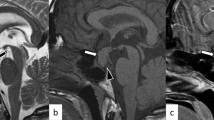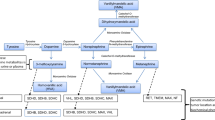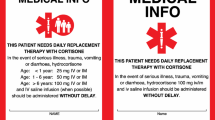Abstract
Cushing’s disease is the most common cause of endogenous hypercortisolemia, and transsphenoidal surgery remains the first line therapy for removal of the ACTH-secreting adenoma. While post-operative remission rates are high in experienced hands, there remains a 2% risk of recurrence per year. Patients with the highest chance for cure are those with small, non-invasive tumors that are visible on pre-operative MRI and identified during surgery and are performed by high-volume pituitary neurosurgeons. Surgery for persistent or recurrent disease is frequently indicated and is most successful in the hands of experienced surgeons and in cases where tumor is visible on MRI.
Similar content being viewed by others
References
Nieman LK, Biller BMK, Findling JW et al (2015) Treatment of Cushing’s syndrome: an endocrine society clinical practice guideline. J Clin Endocrinol Metab 100:2807–2831
Alexandraki KI, Kaltsas GA, Isidori AM et al (2013) Long-term remission and recurrence rates in Cushing’s disease: predictive factors in a single-centre study. Eur J Endocrinol 168:639–648
Valassi E, Biller BMK, Swearingen B et al (2010) Delayed remission after transsphenoidal surgery in patients with Cushing’s disease. J Clin Endocrinol Metab 95:601–610
Fleseriu M, Auchus R, Bancos I et al (2021) Consensus on diagnosis and management of Cushing’s disease: a guideline update. Lancet Diabetes Endocrinol 9:847–875
Goshtasbi K, Lehrich BM, Abouzari M et al (2020) Endoscopic versus nonendoscopic surgery for resection of pituitary adenomas: a national database study. J Neurosurg 134:816–824
Rolston JD, Han SJ, Aghi MK (2016) Nationwide shift from microscopic to endoscopic transsphenoidal pituitary surgery. Pituitary 19:248–250
Barkhoudarian G, Romero AD, Laws ER (2013) Evaluation of the 3-dimensional endoscope in transsphenoidal surgery. Neurosurgery 73:74–78 (discussion ons78–9)
Lonser RR, Nieman L, Oldfield EH (2017) Cushing’s disease: pathobiology, diagnosis, and management. J Neurosurg 126:404–417
Yap LB, Turner HE, Adams CBT, Wass JAH (2002) Undetectable postoperative cortisol does not always predict long-term remission in Cushing’s disease: a single centre audit*. Clin Endocrinol 56:25–31
Fleseriu M, Hashim IA, Karavitaki N et al (2016) Hormonal replacement in hypopituitarism in adults: an endocrine society clinical practice guideline. J Clin Endocrinol Metab 101:3888–3921
Biller BMK, Grossman AB, Stewart PM et al (2008) Treatment of adrenocorticotropin-dependent Cushing’s syndrome: a consensus statement. J Clin Endocrinol Metab 93:2454–2462
Varlamov EV, Vila G, Fleseriu M (2022) Perioperative management of a patient with Cushing disease. J Endocr Soc 6:bvac010
Swearingen B, Biller BM, Barker FG 2nd et al (1999) Long-term mortality after transsphenoidal surgery for Cushing disease. Ann Intern Med 130:821–824
Stroud A, Dhaliwal P, Alvarado R et al (2020) Outcomes of pituitary surgery for Cushing’s disease: a systematic review and meta-analysis. Pituitary 23:595–609
Hammer GD, Blake Tyrrell J, Lamborn KR et al (2004) Transsphenoidal microsurgery for Cushing’s disease: initial outcome and long-term results. J Clin Endocrinol Metab 89:6348–6357
Hofmann BM, Hlavac M, Martinez R et al (2008) Long-term results after microsurgery for Cushing disease: experience with 426 primary operations over 35 years. J Neurosurg 108:9–18
Prevedello DM, Pouratian N, Sherman J et al (2008) Management of Cushing’s disease: outcome in patients with microadenoma detected on pituitary magnetic resonance imaging. J Neurosurg 109:751–759
Lim JS, Lee SK, Kim SH et al (2011) Intraoperative multiple-staged resection and tumor tissue identification using frozen sections provide the best result for the accurate localization and complete resection of tumors in Cushing’s disease. Endocrine 40:452–461
Qiao N, Swearingen B, Hedley-Whyte ET, Tritos NA (2019) The utility of intraoperative cytological smear and frozen section in the surgical management of patients with Cushing’s disease due to pituitary microadenomas. Endocr Pathol 30:180–188
Broersen LHA, Biermasz NR, van Furth WR et al (2018) Endoscopic vs. microscopic transsphenoidal surgery for Cushing’s disease: a systematic review and meta-analysis. Pituitary 21:524–534
Petersenn S, Beckers A, Ferone D et al (2015) Therapy of endocrine disease: outcomes in patients with Cushing’s disease undergoing transsphenoidal surgery: systematic review assessing criteria used to define remission and recurrence. Eur J Endocrinol 172:R227–R239
Rees DA, Hanna FWF, Davies JS et al (2002) Long-term follow-up results of transsphenoidal surgery for Cushing’s disease in a single centre using strict criteria for remission. Clin Endocrinol 56:541–551
Ciric I, Ragin A, Baumgartner C, Pierce D (1997) Complications of transsphenoidal surgery: results of a national survey, review of the literature, and personal experience. Neurosurgery 40:225–236 (discussion 236–7)
Barker FG 2nd, Klibanski A, Swearingen B (2003) Transsphenoidal surgery for pituitary tumors in the United States, 1996–2000: mortality, morbidity, and the effects of hospital and surgeon volume. J Clin Endocrinol Metab 88:4709–4719
Honegger J, Grimm F (2018) The experience with transsphenoidal surgery and its importance to outcomes. Pituitary 21:545–555
de Vries F, Lobatto DJ, Verstegen MJT et al (2021) Outcome squares integrating efficacy and safety, as applied to functioning pituitary adenoma surgery. J Clin Endocrinol Metab 106:e3300–e3311
Donofrio CA, Losa M, Gemma M et al (2017) Safety of transsphenoidal microsurgical approach in patients with an ACTH-secreting pituitary adenoma. Endocrine 58:303–311
Ram Z, Nieman LK, Cutler GB Jr et al (1994) Early repeat surgery for persistent Cushing’s disease. J Neurosurg 80:37–45
Perez-Vega C, Ramos-Fresnedo A, Tripathi S et al (2022) Treatment of recurrent and persistent Cushing’s disease after first transsphenoidal surgery: lessons learned from an international meta-analysis. Pituitary. https://doi.org/10.1007/s11102-022-01215-1
Cardinal T, Zada G, Carmichael JD (2021) The role of reoperation after recurrence of Cushing’s disease. Best Pract Res Clin Endocrinol Metab 35:101489
Roelfsema F, Biermasz NR, Pereira AM (2012) Clinical factors involved in the recurrence of pituitary adenomas after surgical remission: a structured review and meta-analysis. Pituitary 15:71–83
Sughrue ME, Shah JK, Devin JK et al (2010) Utility of the immediate postoperative cortisol concentrations in patients with Cushing’s disease. Neurosurgery 67:688–695
Amlashi FG, Swearingen B, Faje AT et al (2015) Accuracy of late-night salivary cortisol in evaluating postoperative remission and recurrence in Cushing’s disease. J Clin Endocrinol Metab 100:3770–3777
Rutkowski MJ, Flanigan PM, Aghi MK (2015) Update on the management of recurrent Cushing’s disease. Neurosurg Focus 38:E16
Patil CG, Veeravagu A, Prevedello DM et al (2008) outcomes after repeat transsphenoidal surgery for recurrent Cushing’s disease. Neurosurgery 63:266–271
Capatina C, Hinojosa-Amaya JM, Poiana C, Fleseriu M (2020) Management of patients with persistent or recurrent Cushing’s disease after initial pituitary surgery. Expert Rev Endocrinol Metab 15:321–339
Feng M, Liu Z, Liu X et al (2018) Diagnosis and outcomes of 341 patients with Cushing’s disease following transsphenoid surgery: a single-center experience. World Neurosurg 109:e75–e80
Casanueva FF, Barkan AL, Buchfelder M et al (2017) Criteria for the definition of Pituitary Tumor Centers of Excellence (PTCOE): a Pituitary Society Statement. Pituitary 20:489–498
Funding
None applicable.
Author information
Authors and Affiliations
Contributions
Authors PSJ and BS were both involved in the drafting, writing, and editing of this manuscript.
Corresponding author
Ethics declarations
Competing interests
The authors have no competing interests to declare with regards to this manuscript.
Additional information
Publisher's Note
Springer Nature remains neutral with regard to jurisdictional claims in published maps and institutional affiliations.
Rights and permissions
About this article
Cite this article
Jones, P.S., Swearingen, B. Pituitary surgery in Cushing’s disease: first line treatment and role of reoperation. Pituitary 25, 713–717 (2022). https://doi.org/10.1007/s11102-022-01254-8
Accepted:
Published:
Issue Date:
DOI: https://doi.org/10.1007/s11102-022-01254-8




